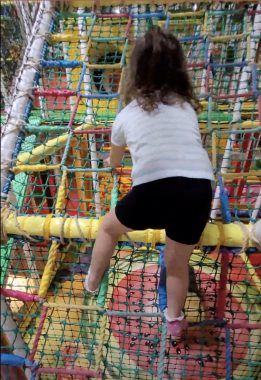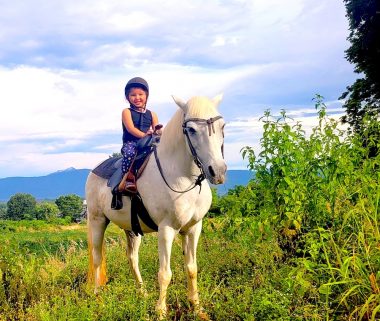Moving Past Negative Comments About Our Daughter With AADC Deficiency
A columnist shares several types of hurtful remarks and how he responds to each
Written by |

It may be an ill-formed sentence someone blurts or deliberate malice. Either way, any negativity expressed about our daughter, spoken or unspoken, goes straight to our hearts.
My skin is thick, and I calculate my responses. Is defending my daughter over a statement that has no direct effect on our lives worth the energy? Or is this a teaching opportunity that could spare future parents the same heartache? I often don’t respond.
After experiencing so much pain, annoying statements do little to affect me. My daughter is not being harmed.
However, it’s unfortunate that so many aren’t considerate of the rare disease community.
Deciding to open up
After my daughter, Rylae-Ann, was diagnosed with aromatic l-amino acid decarboxylase (AADC) deficiency, my wife, Judy, and I shut ourselves off from the world. It would take us about three years to share our story.
I’m proud of our family for overcoming our fear of opening up, though doing so makes us vulnerable to criticism and negative comments. Yet the rewards for our family and other families facing difficulties are worth it.
Although they may sound trivial, the following are the types of comments that stop us in our tracks and provoke an emotional response.

Rylae-Ann’s support network helps her to develop and to experience the joys of life. (Courtesy of Richard E. Poulin III)
Unnecessary sympathy
One day our daughter had a mild tantrum. As a teacher, I’ve seen much worse and know it’s something children do while developing social, emotional, and language skills.
Judy was dropping off our daughter at an after-school class, but along the way, Rylae-Ann was already fussing. Now that she would be separated from her mom, the meltdown was imminent. The parents who knew her began to drop their voices and stare.
After Judy walked away from Rylae-Ann, the tantrum ensued. Judy kissed her and walked off. Within five minutes Rylae-Ann was back to normal, distracted by everything going on. Another parent caught up to Judy. With a pat on the back, they said everything would be all right and not to worry.
Not to worry? What is there to worry about? I was just dropping off my kid, and she had a tantrum. What’s up with the pat on the back? These thoughts raced through Judy’s head and began to morph into pain and then anger. She didn’t respond and walked off.
No harm was done, but the sympathy was unnecessary and struck a chord with her.

Rylae-Ann sits in front of Taipei 101 after her gene therapy surgery. (Courtesy of Richard E. Poulin III)
The backhanded compliment
These compliments seem nice on the surface, but are laced with insults. We receive many of these, and most people don’t even realize it.
One memorable comment was, “Gosh, you’re amazing. There’s no way I would be able to take care of her.” Judy is just a patient mom. As teachers, our patience is tested every day. No superpower required.

Rylae-Ann completes her play-based learning sessions while in a standing frame. (Courtesy of Richard E. Poulin III)
The direct statement
Sometimes comments are direct and clear. Maybe it’s a slip of the tongue, or someone didn’t know we were within earshot. One recent comment was, “Rylae is the most difficult child to take care of.”
Sometimes I appreciate when people are direct. I like when children are honest and ask, “What’s wrong with her?” This is a teachable moment; they haven’t yet developed language for certain situations. My educator mode activates, and we have a mini-lesson.
With adults, I should probably respond with the same directness and give them a mini-lesson, too, but I divert my energy toward my daughter instead.

Rylae-Ann enjoys the waves moving beneath her feet as she explores the world. (Courtesy of Richard E. Poulin III)
Exclusion
The first time we faced exclusion was when Rylae-Ann was unable to enroll in a school because she was “behind other kids.” As an educator, I understand that the school wants to properly support each child, but this came at a time when the rare disease world was new to us.
When children exclude another student, it can be a form of bullying if the purpose is to alienate them or encourage others not to associate with them. Social exclusion is one of the most common forms of bullying, and in our teaching professions we keep a constant eye out. Rylae-Ann often enjoys playing alone, but recently she has been inching toward other students.
Everyone at her current school has been very inclusive. However, when visiting an indoor playground, a group of girls decided to run away from Rylae-Ann every time she came near. My daughter wasn’t bothered by it, and I happily jumped in to be her buddy.
We always have a blast, but collaborative play is an essential social milestone. We have to encourage her to self-advocate and to communicate with other children. When she joins public play areas like playgrounds, we let her explore first. If she gets excluded, then we step in and teach.

Rylae-Ann independently climbs a rope wall at an indoor playground. (Courtesy of Richard E. Poulin III)
Continuing to move forward
It pains me greatly to know that this criticism deeply affects my wife. While I’ve developed a thick skin, I’d be lying to say I’m immune. When I hear negative comments, I bite my tongue and act as if I didn’t. When I hear whispers or backhanded compliments, I smile and let them pass. When places or people exclude Rylae-Ann, I hold my head high and move on to ones who are more accepting.
If people knew the challenges our daughter has overcome already in her short life, they’d be amazed. Most people see a child with difficulties, but don’t realize the miracle she is. Those who choose to engage learn about her accomplishments and see firsthand the talents she possesses.
This column is for parents and caregivers who face similar challenges. Judy and I went through depression and are still prone to it whenever negative comments are hurled toward our daughter. We continue to reach out to our support network and remember that there are parents like us with children just like our daughter. For them, we continue to move forward past the negative energy along our journey to beautiful destinations.

Rylae-Ann continues to ride on a journey to beautiful destinations. (Courtesy of Richard E. Poulin III)
Note: AADC News is strictly a news and information website about the disease. It does not provide medical advice, diagnosis, or treatment. This content is not intended to be a substitute for professional medical advice, diagnosis, or treatment. Always seek the advice of your physician or other qualified health provider with any questions you may have regarding a medical condition. Never disregard professional medical advice or delay in seeking it because of something you have read on this website. The opinions expressed in this column are not those of AADC News or its parent company, Bionews, and are intended to spark discussion about issues pertaining to aromatic l-amino acid decarboxylase deficiency.







Leave a comment
Fill in the required fields to post. Your email address will not be published.